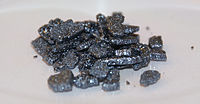
Photo from wikipedia
recent review finds “strong evidence” to support breast pocket irrigation with 10% povidone-iodine solution and/or A antibiotics. The authors state that “povidone-iodine lavage with or without antibiotics is more effective… Click to show full abstract
recent review finds “strong evidence” to support breast pocket irrigation with 10% povidone-iodine solution and/or A antibiotics. The authors state that “povidone-iodine lavage with or without antibiotics is more effective at reducing the risk of capsular contracture than no lavage or saline alone.” Saeg et al conclude, “Breast implant wounds should receive gravity lavage with povidone-iodine or antibiotics to reduce the risk of capsular contracture and infection.” Introduced in 1986, the practice of irrigating a breast woundwith povidone-iodine solution is so ubiquitous and has gone on for so long that most plastic surgeons do not give this routine a second thought. It may surprise many plastic surgeons to learn that this product is not sterile. Bottles of Betadine are labeled “Topical Bactericide.” The warnings, “Antiseptic Non-Sterile Solution” and “For External Use Only,” appear on the bottles. Adams and Calobrace believe that the inside of the bottle is sterile, if not the outside. However, this statement is not true for the “stock” 10% povidone-iodine solution. Adams recommends against a lower concentration because of poor in vitro antimicrobial activity when using a 5% solution. Betadine is an over-the-counter topical antiseptic, intended as a preoperative skin preparation, not a solution to be diluted and poured into an open surgical wound. The US Food and Drug Administration (FDA) cautions, “If a product does not state “sterile” on the label, health care professionals should be aware that they are using a nonsterile product.” Containers of Betadine 10% are nonsterile. Only the 5% povidone-iodine ophthalmic prep solution, produced by another manufacturer and labeled “sterile,” is sterile. Sterile products are treated with a process during manufacturing to eliminate microorganisms. The sterile 5% povidone-iodine ophthalmic prep solution is FDA approved; the 10% povidone-iodine solution is not. The 30 mL of 5% ophthalmic solution is available by prescription only and approved only for ophthalmic use. Betadine 10% is an over-the-counter product, and therefore, FDA approval is not mandatory, but the medication must be used for the labeled purpose, which does not include breast pocket irrigation. Adams reassures plastic surgeons, “it should be noted that Betadine was reapproved by the FDA in August of 2017 and is no longer off-label to use.” This statement is misleading because Betadine 10% solution is not approved and has never been approved by the FDA, and internal use is outside the labeled indication. Adams' reference was to an August 28, 2017, communication from the FDA approving a labeling change for Natrelle breast implants (AbbVie, Inc, North Chicago, Ill), not Betadine. The statement read, “Approval for changes to the labeling including 1) the removal of the Betadine warning against breast implant exposure to Betadine brand povidone-iodine 10% (applicable to generic versions as well) from the patient and physician labeling, and 2) modifications to the language in the physician and patient labeling regarding the potential risk of breast implant associated anaplastic large cell lymphoma (BIAALCL).” This labeling change was, in part, an acknowledgment that Betadine irrigation was unlikely to affect the implant shell integrity. It was not an endorsement by the FDA that “What was formerly an off-label practice can be openly practiced by plastic surgeons as an anti-infective and biofilm-mitigation strategy.” Any nonsterile solution dispersed into an open wound creates a risk of contamination. In the 1970s, it was assumed that antiseptics were free of microbial contamination because of their pharmacologic activity. In 2013, the FDA addressed safety issues after receiving reports of infections that were confirmed to have been caused by contaminated topical antiseptics, including povidone-iodine. These infections are likely underreported. Extrinsic contamination may be caused by dilution with contaminated water or handling and storing solutions under nonsterile conditions. Intrinsic contamination occurs during the manufacturing process. In these cases, microbes have been isolated from pharmaceutical water supplies and nonsterile manufacturing environments. Once introduced into the product during manufacturing, these bacteria may remain viable and multiply (including Ralstonia pickettii). An in vitro study shows that a 5-minute exposure to a 5% solution of povidone-iodine allows a heavy growth of methicillin-resistant Staphylococcus aureus and Pseudomonas aeruginosa. Pseudomonas aeruginosa has been identified as an intrinsic contaminant of povidone-iodine solution acquired during manufacturing. Lineaweaver et al evaluated the effect of 1% povidone-iodine when applied to cultured human fibroblasts, finding no fibroblast survival at 24 hours (ie, 100% cytotoxicity). The same result was obtained when solutions of 0.25% acetic acid, 0.5% sodium hypochlorite, and 3% hydrogen peroxide were used. The authors concluded that these solutions are unsuitable for use in wound care. By contrast, antibiotic solutions (bacitracin, neomycin, and kanamycin)
Journal Title: Annals of Plastic Surgery
Year Published: 2021
Link to full text (if available)
Share on Social Media: Sign Up to like & get
recommendations!